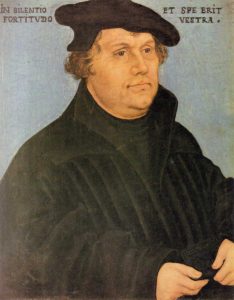 The Lord be with you,
The Lord be with you,
In his afternoon sermon, delivered on Easter Tuesday, April 3, 1526, Martin Luther considered several Old Testament people and how they prefigured Jesus. The excerpt below is his treatment of Moses. I especially like his take on the burning bush. I think I’ll use in in my Exodus Musings, when I get to those verses.
Likewise, when Moses was in Egypt, the king became hostile to him so that he fled to Midian [Exod. 2:15]. There he married the priest’s daughter [Exod. 2:16-21]. On Mount Horeb he saw a bush, etc., that was green and on fire but not yet ashes. “This is a miracle,” he said. “I should approach it.” When he was there, [God said]. “Take your sandals off your feet,” etc. [Exod. 3:5]. They (people like Bonaventure) apply this figure to the virgin: “O Mary, your virginity,” etc. (Thus they understand the bush Moses saw in Exodus as virginity.) It is to be [interpreted according to] the analogy of faith [Rom. 12:6]. The bush is Christ, in whom God dwells; the bush is green because He is a man innocent of any guilt. Just as the bush sprang forth in the desert without any human work, so He was born without any male [work], etc. God is in the bush, so for that reason it—that is, the bush—cannot be burned up; that is, the humanity of Christ is in the midst of suffering and dies, and nevertheless it is not dead: that is miraculous. Thus Christ is not only pure man—otherwise Satan would have led Him away—but since the Deity dwells bodily in that man [Col. 2:9], therefore it was impossible for Him to be burned up, but rather in the midst of death that person lives. The fire should have been stronger than the bush, but the opposite is true. Thus death should have devoured Christ, but Christ is stronger than death, etc. The words square with this, for it says, “I am the God of Abraham” [Exod. 3:6]. Christ Himself applied these words to the resurrection of Christ [when He said], “He is not the God of the dead but of the living” [Matt. 22:32]. Therefore, these three [Abraham, Isaac, Jacob] are alive. Although these words fail with the bush, which dies, these three are alive before God, for whoever lives is thoroughly and totally alive. Otherwise He would have said, “I am the God of the soul of Abraham,” but Christ strongly concludes that the resurrection of the dead takes place. Who would ever have believed that the resurrection was included in these words? From the bush you have it: God, who suffers and dies in Christ, makes them alive and raises them up.
The bush here is a figure; the words about the three who He says, are alive indicate that He distributes and gives His resurrection not only to them but also to all who believe His words: “Whoever believes in Me, though he die, yet shall he live” [John 11:25]. “I am,” He says, “the resurrection,” just as He said in Exodus: “I am the God of Abraham” [Exod. 3:6]. You say, “Nevertheless, he is dead.” He [may be] dead to you, but he is alive before God. But how He can accomplish that has not been entrusted to us so that we may understand it but so that we may believe it, because he says in John [11:25]: “I am the resurrection and the life.” Therefore, death for the Christian is a leap into resurrection and life.
Martin Luther, Luther’s Works v. 56, p. 175-176
